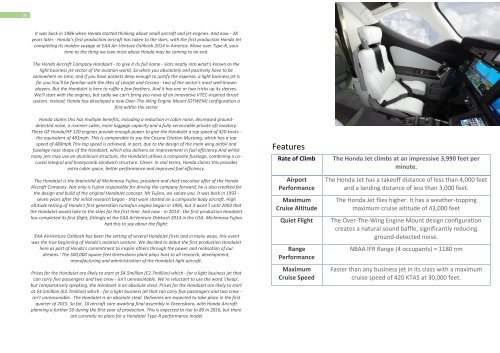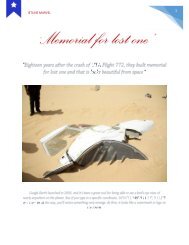Jetline marvel
This first issue is the beginning of our long journey which packed with striking Aviation reports , airlines reviews , articles,stories and most of all phenomenal imagery by reports from all over the globe about aviation & aerospace enthusiast people. Jetline Marvel is Synchronized by Aerospace Science Research Foundation(India) as well as Aerospace Science Club, Bengaluru.
This first issue is the beginning of our long journey which packed with striking Aviation reports , airlines reviews , articles,stories and most of all phenomenal imagery by reports from all over the globe about aviation & aerospace enthusiast people. Jetline Marvel is Synchronized by Aerospace Science Research Foundation(India) as well as Aerospace Science Club, Bengaluru.
Create successful ePaper yourself
Turn your PDF publications into a flip-book with our unique Google optimized e-Paper software.
35<br />
JETLINE <strong>marvel</strong> I January 2015<br />
It was back in 1986 when Honda started thinking about small aircraft and jet engines. And now - 28<br />
years later - Honda’s first production aircraft has taken to the skies, with the first production Honda Jet<br />
completing its maiden voyage at EAA Air-Venture Oshkosh 2014 in America. Move over Type-R, your<br />
time as the thing we love most about Honda may be coming to an end.<br />
The Honda Aircraft Company HondaJet - to give it its full name - slots neatly into what’s known as the<br />
light business jet sector of the aviation world. So when you absolutely and positively have to be<br />
somewhere on time, and if you have pockets deep enough to justify the expense, a light business jet is<br />
for you.You’ll be familiar with the likes of Learjet and Cessna - two of the sector’s most well-known<br />
players. But the HondaJet is here to ruffle a few feathers. And it has one or two tricks up its sleeves.<br />
We’ll start with the engines, but sadly we can’t bring you news of an innovative VTEC-inspired thrust<br />
system. Instead, Honda has developed a new Over-The-Wing Engine Mount (OTWEM) configuration a<br />
first within the sector<br />
Honda claims this has multiple benefits, including a reduction in cabin noise, decreased grounddetected<br />
noise, a roomier cabin, more luggage capacity and a fully-serviceable private aft lavatory.<br />
These GE Honda/HF 120 engines provide enough power to give the HondaJet a top speed of 420 knots -<br />
the equivalent of 483mph. This is comparable to say the Cessna Citation Mustang, which has a top<br />
speed of 480mph.This top speed is achieved, in part, due to the design of the main wing airfoil and<br />
fuselage nose shape of the HondaJet, which also delivers an improvement in fuel efficiency.And whilst<br />
many jets may use an aluminium structure, the HondaJet utilises a composite fuselage, combining a cocured<br />
integral and honeycomb sandwich structure. Clever. In real terms, Honda claims this provides<br />
extra cabin space, better performance and improved fuel efficiency.<br />
The HondaJet is the brainchild of Michimasa Fujino, president and chief executive offer of the Honda<br />
Aircraft Company. Not only is Fujino responsible for driving the company forward, he is also credited for<br />
the design and build of the original HondaJet concept. Mr Fujino, we salute you. It was back in 1993 -<br />
seven years after the initial research began - that work started on a composite body aircraft. High<br />
altitude testing of Honda’s first generation turbofan engine began in 1995, but it wasn’t until 2003 that<br />
the HondaJet would take to the skies for the first time. And now - in 2014 - the first production HondaJet<br />
has completed its first flight, fittingly at the EAA AirVenture Oshkosh 2014 in the USA. Michimasa Fujino<br />
had this to say about the flight:<br />
'EAA AirVenture Oshkosh has been the setting of several HondaJet firsts and in many ways, this event<br />
was the true beginning of Honda’s aviation venture. We decided to debut the first production HondaJet<br />
here as part of Honda’s commitment to inspire others through the power and realisation of our<br />
dreams.' The 500,000 square feet Greensboro plant plays host to all research, development,<br />
manufacturing and administration of the HondaJet light aircraft.<br />
Prices for the HondaJet are likely to start at $4.5million (£2.7million) which - for a light business jet that<br />
can carry five passengers and two crew - isn’t unreasonable. We’re reluctant to use the word 'cheap',<br />
but comparatively speaking, the HondaJet is an absolute steal. Prices for the HondaJet are likely to start<br />
at $4.5million (£2.7million) which - for a light business jet that can carry five passengers and two crew -<br />
isn’t unreasonable. The HondaJet is an absolute steal. Deliveries are expected to take place in the first<br />
quarter of 2015. So far, 10 aircraft sare awaiting final assembly in Greensboro, with Honda Aircraft<br />
planning a further 50 during the first year of production. This is expected to rise to 80 in 2016, but there<br />
are currently no plans for a HondaJet Type-R performance model<br />
Features<br />
Rate of Climb<br />
Airport<br />
Performance<br />
Maximum<br />
Cruise Altitude<br />
Quiet Flight<br />
Range<br />
Performance<br />
Maximum<br />
Cruise Speed<br />
The Honda Jet climbs at an impressive 3,990 feet per<br />
minute.<br />
The Honda Jet has a takeoff distance of less than 4,000 feet<br />
and a landing distance of less than 3,000 feet.<br />
The Honda Jet flies higher. It has a weather-topping<br />
maximum cruise altitude of 43,000 feet<br />
The Over-The-Wing Engine Mount design configuration<br />
creates a natural sound baffle, significantly reducing<br />
ground-detected noise.<br />
NBAA IFR Range (4 occupants) = 1180 nm<br />
Faster than any business jet in its class with a maximum<br />
cruise speed of 420 KTAS at 30,000 feet.






